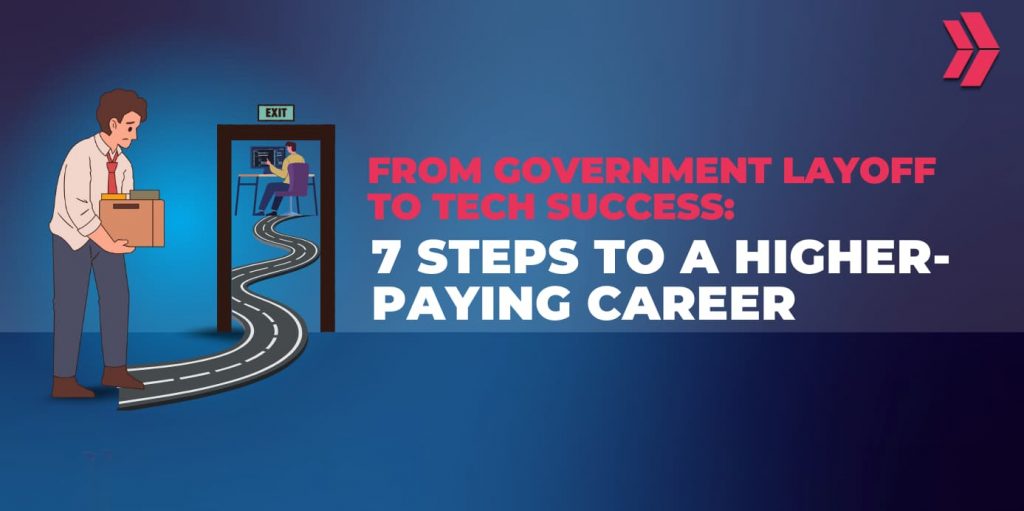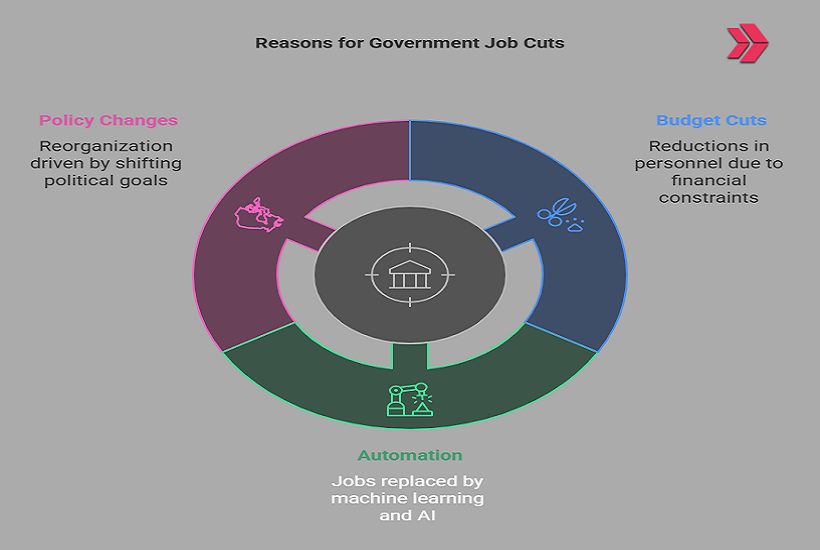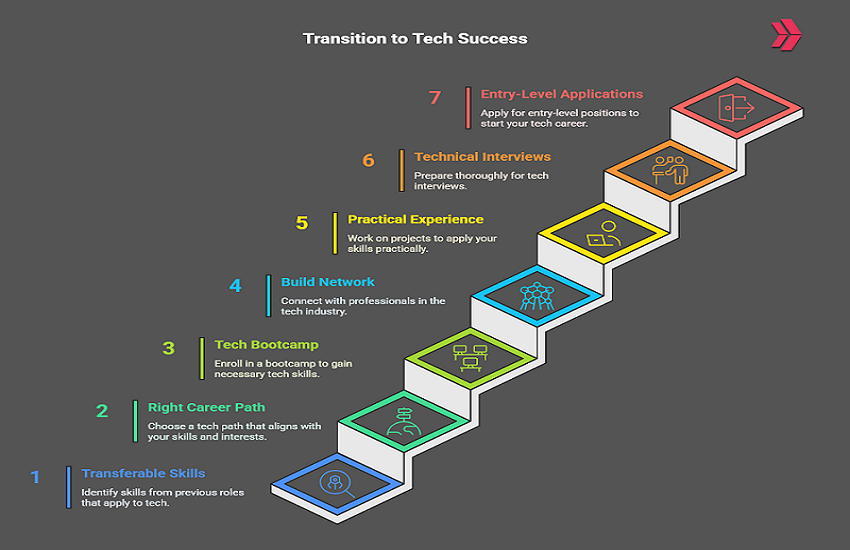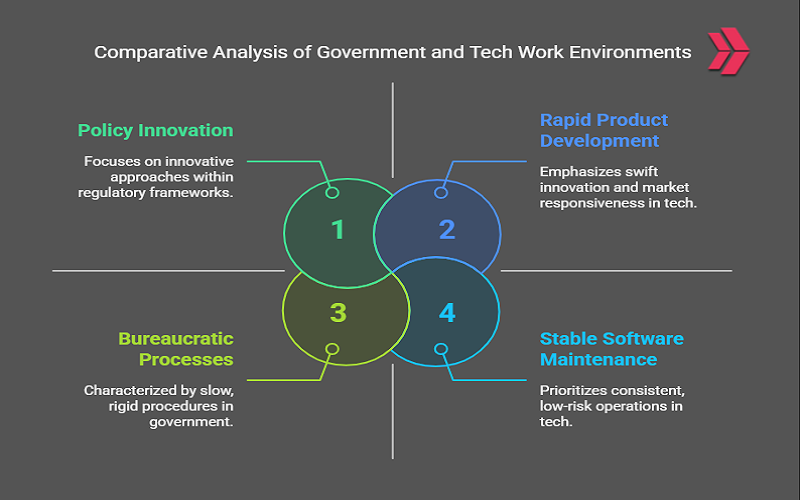Government layoffs are becoming a more pressing concern for public sector employees. Many professionals are searching for new opportunities because the retail and government sectors experienced the highest rates of job losses, according to PYMNTS research from 2025.
Although facing government layoffs can be intimidating, they also offer a chance to learn, comprehend, and prepare for future tech professions. This change also creates opportunities for rich tech sector professions. One can better navigate this transition if they familiarize themselves with the tech scene, acquire the necessary skills, and prepare for a successful career change. There is a rising demand for tech specialists, so this is a viable option for people who have lost their jobs in the government sector and are now considering a tech career.
This guide will assist you in your search for tech bootcamps and IT jobs if you’re seeking to transition from government unemployment to a successful tech career.

Why Are Government Employees Facing Layoffs?
Budget cuts, new technologies, and changing government priorities are common causes of layoffs in the public sector. Many public sector positions are being eliminated to cut costs and increase efficiency due to the impact of digital transformation and automation on various industries. Jobs that were once considered safe are becoming more precarious as agencies try to increase efficiency. Because software and AI can now handle repetitive tasks, this trend is especially noticeable in administrative and clerical positions.
What Are the Main Reasons Behind Government Job Cuts?
Modernization efforts and fiscal austerity measures, which aim to cut costs and streamline services, are the main causes of government job cuts. Technological integration, which replaces routine tasks, will reduce the need for human labor in certain departments.
Here are the primary reasons government employees are being laid off:
- Budget Cuts: As governments are put under more and more pressure to cut spending, there will be a reduction in personnel.
- Automation: Machine learning and artificial intelligence are taking over formerly manual processes.
- Policy Changes: Public sector departments undergo reorganization when political goals shift.

Which Public Sector Jobs Are Most Affected by Layoffs?
In government positions, layoffs primarily impact administrative, clerical, data entry, and customer service positions. These positions are frequently the first to be automated or outsourced as a result of cost-cutting initiatives.
What Makes the Tech Industry an Ideal Career Path After Government Layoffs?
Opportunities abound in the tech industry due to its strong demand, competitive salaries, and rapid growth. For those who have lost their jobs in the government, a career in technology may be the best option due to its stability of employment, high pay, and room for advancement.
How Can Laid-Off Government Employees Successfully Transition to Tech?
7 steps that laid-off government employees can take to successfully transition to technology are as follows:
- Step 1: Identifying Transferable Skills
- Step 2: Choosing the Right Tech Career Path
- Step 3: Enrolling in a Suitable Tech Bootcamp
- Step 4: Building a Professional Network
- Step 5: Gaining Practical Experience through Projects
- Step 6: Preparing for Technical Interviews
- Step 7: Applying for Entry-Level Positions

Step 1: Identifying Transferable Skills
Strong analytical, organizational, and communication abilities are frequently exhibited by government employees. Identification of these transferable skills facilitates their alignment with appropriate positions in the technology sector, including data analysis, project management, and UX/UI design.
Step 2: Choosing the Right Tech Career Path
Selection of the appropriate IT career path is essential. Career opportunities in the technology sector are extensive, encompassing cybersecurity and software development. Conducting research on IT positions and recognizing your interests and strengths will assist you in selecting the appropriate career path. Employees should also assess market demand. Among the most popular career transitions are positions such as cybersecurity specialist, data analyst, and software developer.
Step 3: Enrolling in a Suitable Tech Bootcamp
Tech bootcamps provide intensive, streamlined education that produces graduates with marketable skills. For recent career changers from public service, programs like Clarusway offer intensive training.
Step 4: Building a Professional Network
Building a network is essential for breaking into the tech industry. You can improve your job prospects and gain valuable insights into your industry by joining online communities, going to tech events, and interacting with professionals on LinkedIn and similar platforms.
Step 5: Gaining Practical Experience through Projects
The gap in experience can be filled through hands-on experience gained through volunteer work or real-world projects. Putting together a portfolio shows prospective employers that you have the practical skills they are looking for, as well as that you are committed to an IT career.
Step 6: Preparing for Technical Interviews
Coding challenges, problem-solving exercises, and whiteboarding sessions are frequently implemented during technical interviews. Success rates can be enhanced by employing resources such as mock interviews and IT job preparation courses.
Step 7: Applying for Entry-Level Positions
Candidates should actively seek out entry-level positions once they have acquired the required skills. Opportunities can be secured by using resumes that highlight relevant experience and by utilizing job boards that focus on IT career paths.
How Does the Tech Industry Compare to Government Jobs?
Moving from a government position to an IT job might be daunting at first, but it gets easier once you learn about the similarities and differences.
What Are the Similarities Between Government and Tech Work Environments?
Despite their apparent differences, government and tech workplaces have several important things in common:
Structure and Collaboration
- Teamwork: Collaborating is critically important in both settings. Working in teams to accomplish common objectives is commonplace in many fields, including government and technology.
- Processes and Hierarchies: Decision-making and operational procedures are typically well-defined in both industries. Even though tech is generally more casual, workflows and hierarchies are still in place to make sure everything runs smoothly.
Problem Solving
Governments deal with political and social issues, while tech companies focus on technological and user-centric concerns.
These shared qualities can make the transition smoother for those exploring a new IT career path.
What Are the Key Differences Between Government and Tech Work Environments?
Government and tech work environments indeed have stark contrasts, shaped by their respective missions and operational styles. Here’s a breakdown of key differences:
Purpose and Goals
- Government: Mainly concerned with serving the public and improving society. The public good, in the long run, is usually the driving force behind decisions and initiatives.
- Tech: Innovation and profitability are the driving forces. Making innovative goods, services, or technology is a common aim so as to maintain a competitive edge.
Pace and Innovation
- Government: Because of red tape, rules, and the need to reach a consensus, it moves at a snail’s pace. New ideas can emerge slowly.
- Tech: Constantly changing with new features, improvements, and updates to existing products. Keeping up with the times requires innovation, which is a constant.
Job Security and Risk
- Government: Reputed for stability, it offers regular hours and benefits, including pensions and great employment security.
- Tech: Job stability is usually correlated with company performance or the general state of the economy. Still, it may pay more financially.
Work Culture
- Government: Typically organized and formal. Processes and clear hierarchies control the decision-making.
- Tech: More relaxed and active. We often see open floor plans, relaxed dress standards, and flat organizational charts.
Performance Metrics
- Government: Success is measured by policy implementation, regulation compliance, and social impact.
- Tech: Market share, user adoption, revenue, and growth are frequently used as metrics.
Compensation
- Government: Provides solid benefits and moderate wages with little opportunity for rapid financial advancement.
- Tech: Offers attractive compensation, bonuses, benefits, and faster advancement than government jobs. These are explained in “Top 9 Reasons to Launch a Tech Career.” However, it comes with a greater level of risk.

What Are the Biggest Challenges When Moving from Government to Tech?
Quickly learning new technical skills, adjusting to a fast-paced environment, and getting over the “no experience” stigma are the main obstacles. Achieving success requires skillfully navigating these challenges. Many people find that structured programs, like coding bootcamps, help them learn new skills more quickly and effectively.
How Can You Overcome the “No Experience” Barrier?
The question, “Can I Become A Coder Without A Degree?” is on the minds of many people making the transition. The answer is yes. Coding bootcamps and other intensive training programs enable individuals to quickly acquire the necessary skills. An individual’s marketability to potential employers is greatly enhanced by building a solid portfolio and obtaining practical experience through internships or freelancing.
Final Thoughts
It is truly possible to make the leap from a government job to a tech career if one takes the correct steps. It is possible to adapt to this change by taking stock of your transferable skills, researching and selecting an appropriate IT career path, and working to increase your practical experience. There are excellent training programs and resources available from organizations like Clarusway that can assist you in making the transition. People hit hard by government layoffs would do well to look into the expanding technology sector, which is always looking for talented workers.




